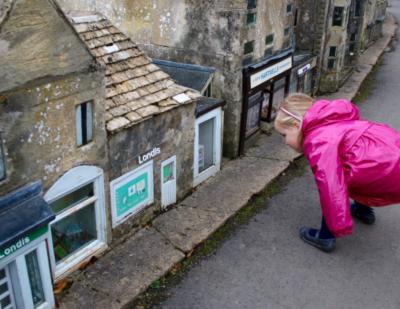On infinite villages
17 Oct 2015

Just behind the New Old Inn (a name I particularly like) in Bourton-on-the-Water is a model village, modelled on the village of Bourton-on-the-Water. The model makers must’ve been my kind of people, and shared my love of “meta” because they made it a member of the set of things that describe themselves, a bit like this sentence would be, if it talked about itself. Which it does. Anyway, what I mean is: they included a model of the model inside the model, and a model model model inside it. At 1:9 scale things get pretty small after that, so I’m not sure how far the recursion continues.
The experience got me thinking about what happens when you point a camera at a screen and create one of those seemingly infinite tunnels of screens showing screens showing screens. The same sort of thing happens when you stand between two mirrors, but it always irritates me that my own reflection sort of gets in the way of the end of the tunnel and so you can’t quite see the bottom to find out what happens as the speed of light becomes significant and everything turns into a black hole or whatever would happen if it could actually carry on for ever. The mirror tunnel differs from a “TV tunnel” in two regards. Firstly, the “refresh rate” is much lower in the TV tunnel. You can poke your finger in briefly and watch as it “falls” down the tunnel into the distance. Secondly, since a camera captures what it “sees” and the TV displays it in fixed orientation, you can twist or slide the camera and get twist or curve effects in your TV tunnel. Mirror tunnels are straight, if the mirrors are parallel.
The orientation of the model village is not the same as the orientation of the real village. The model river Windrush flows in a southwesterly direction, rotated by 90 degrees from the real thing. At least it does when its flow isn’t briefly interrupted by the face-down form of a two-year old! Iris lasted 20 seconds before she had a bit of an unplanned entry into the replica river. She got over it quickly, though, literally and figuratively. The rotation means that when you get to the model inside the model, figuring out which way is which takes a moment. Like a twisting TV tunnel, the meta models “go round” inside each other.
The model village is excellent. Churches, shops, nearby avian attractions and trees are recreated in detail. It must’ve taken quite a while. Long enough perhaps for a thoughtful model maker to stop and ponder the chronological implications of what they were doing. Some of the models have little accompanying notices - “this was the site of the museum when the model was built”, for example - so in a sense we are exploring a snapshot in time. At the commencement of modelling in the 1930s though, the model village didn’t exist, so its inclusion inside itself is an inconsistency. I’m glad this anachronism has been allowed. Thinking a bit more about it, it might not even be an anachronism: if the modelling began at the other end of the village, then a partially-complete model village would be an unanachronistic interpretation of reality. Pleasingly this leads me back to my TV tunnel analogy: putting aside the notices about the “normal” parts of the model, we can interpret the model model as a “live” snapshot because it would’ve arrived at this state by now, as long as we assume a sensible “refresh rate”. In this interpretation there would be a vanishingly small, incomplete model of a model of a model of a model, with tiny little imaginary craftspeople working away at the subatomic scale.
I hope to visit again one day. Maybe Iris will bring me and Sarah in our dotage by when the pub will inevitably have been renamed Ye Olde New Old Inn.
< Previous post | Next post >Favourite posts
- On wiggly lines and being normal
- On infinite villages
- Running a race backwards
- Brainmaking
- Their tables were stored full, to glad the sight
- The structure of a smell
Recent posts
- Start your holidays with a meta-alarm
- PGN files from handwritten chess notation
- Souvenirs des villes européennes
- Pic'n'mix reinvented
- Super slow-mo Tetris
Blog archives
Posts from 2012, 2013, 2014, 2015, 2016, 2017, 2018, 2019, 2020, 2021, 2022, 2023, 2024.